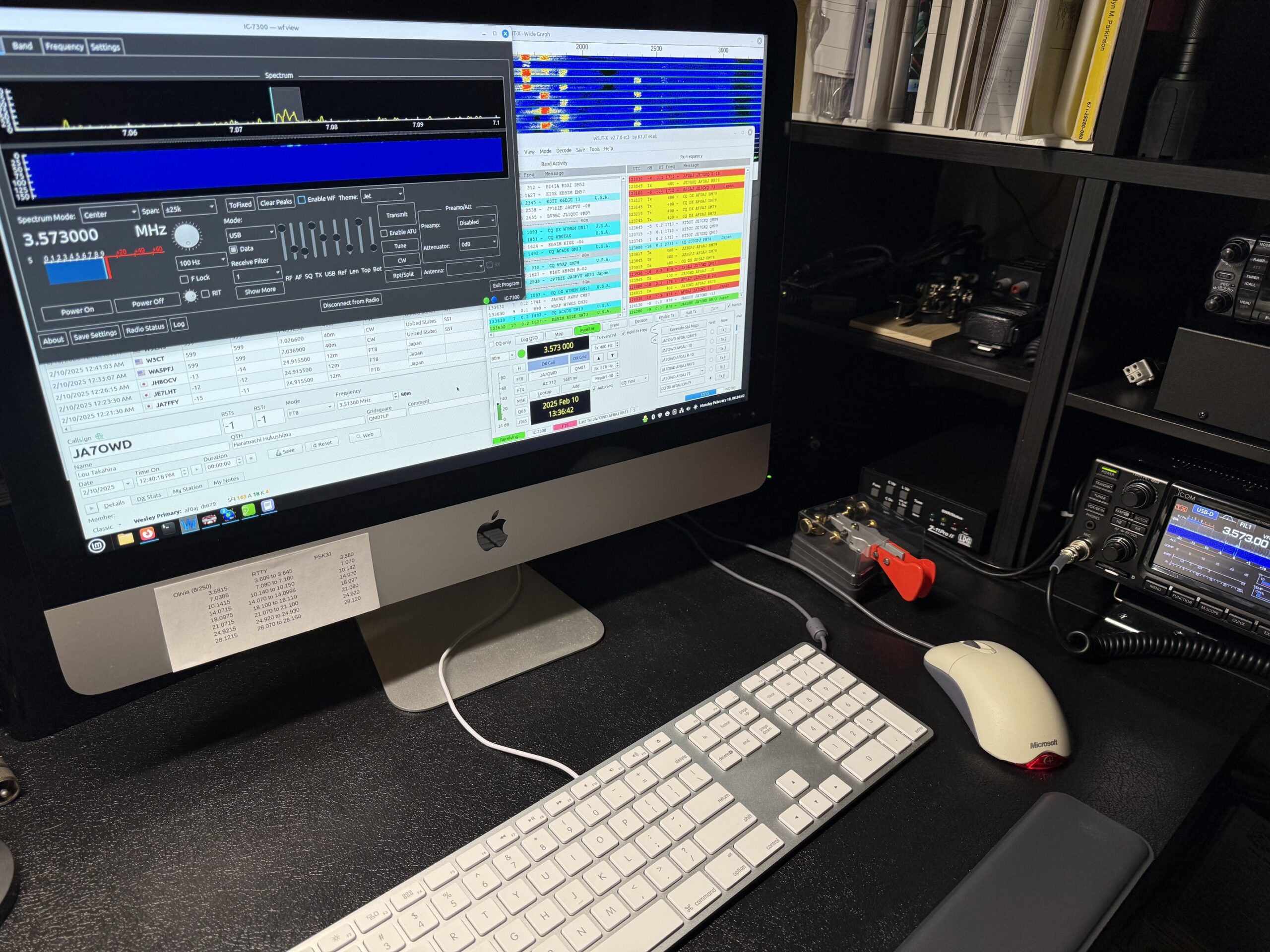After helping an old friend prepare for a move, I ended-up with a pair of old iMacs, and promised to wipe them of data, then take them to the local electronics recycler along with some other old stuff of mine on my next (long) drive to the facility. One of them was barely working, but I got it cleared-off, and the other seemed to be perfectly functional — but at 11 years old, it was no longer supported with macOS updates. They’d been sitting in a closet since, waiting for me to find time to get them taken in. A couple of months ago, I had a sudden realization: Couldn’t I just put Linux on the working iMac? Thus began an interesting chain of events that’ll be fodder for blog posts for quite a long time to come.
I’m old enough to remember the days when computing just wasn’t that easy, or particularly friendly. I cut my programming teeth using a Teletype (a real one, using paper) to connect with a timeshare system with an acoustically coupled modem sitting next to a rotary dial telephone. I’ve even saved some simple BASIC language programs on the Teletype machine’s paper tape. (To be very clear, these things were outdated even when I was using them, and I was just a kid at the time.) I’ve used floppy disks extensively, and cassette tape loading of software before that. My point is that the cushy experience of a GUI like Windows or macOS on internet-connected PCs is a walk in the park in comparison, and the idea of a smartphone with apps was the stuff of science fiction back when I was pecking-out programs on my Tandy Color Computer.
Despite this experience, the entire idea of Linux, with its terminal windows and command prompts and sudo commands and the need to use chmod didn’t scare me, but I’ve grown accustomed to a computing experience that doesn’t require such nuts-and-bolts effort despite otherwise using a modern GUI front-end. Suddenly finding myself inspired to go there anyway was a surprise, even to me. But over the past year, and at least in part due to the people I’m interacting with on Mastodon, not to mention my rekindled deep interest in ham radio, I find myself being a bit… I wouldn’t say nostalgic necessarily, but perhaps reflecting on my past a bit. Compared to my somewhat younger self, I feel as if I’ve lost something about the nature of who I am over the past decade or two, something I’d like to recapture.
The Choice
There are myriad Linux distributions around these days, and I could have picked any of a wide range of options to try throwing Linux on an old Mac. I ended-up choosing Linux Mint, and to be honest, I don’t even remember how I found Mint, let alone chose to use it. I suspect I’d web-searched for “Linux on a Mac” and stumbled upon it. But reading-up on Mint showed that it’s widely considered a good choice for those new(-ish) to Linux. In addition, they made it very easy to try it out without making any commitments or system changes, simply by installing it on a USB thumb drive, and booting the Mac from that thumb drive. So, the decision to try it out was quite easy.
The Evaluation
I followed the directions carefully, and with a USB key inserted into the back of the iMac, I booted from the key. In short order, a Linux Mint instance was running on the old machine (specifically, an iMac 21.5-inch, Late 2013 model), with everything but the WiFi working perfectly. (I correctly surmised that the WiFi would require a full install with the correct drivers, but more on that in a moment.)
I clicked around a bit, loaded LibreOffice Writer and tinkered, navigated around the menus a bit, and was satisfied that Linux Mint would be a good match for the old hardware. I clicked the install button available from the USB-key-booted instance, and in very short order, I could remove the USB thumb drive and boot my fresh Linux Mint installation from the hard disk. The entire operation — from initial evaluation to a working, permanent installation — took less than half an hour.
As already mentioned, the only bit that didn’t work was the WiFi. This is not installed by default for whatever reason, but getting it going was a breeze. All I had to do was run Linux Mint’s Driver Manager utility; it detected not only the WiFi hardware, but offered-up the correct driver for it. A simple mouse click and a short wait later, voila, working WiFi.
The Result
This old iMac (I’m using it to write this post) was not exactly a top-spec model in its day. It has an Intel Core i5-4570R quad-core CPU running at 2.7 GHz. It’s equipped with just 8 Gig of RAM, and the hard drive is a relatively slow, conventional 1TB 5400 RPM hard drive manufactured by Hitachi. But those low-end specs were sufficient for my envisioned use: running ham radio software, and doing some general web browsing.
Migrating from the use of my MacBook Pro running macOS for FT8 operation, logging, and CAT radio control was simpler than I expected it to be. I’d more or less made my choices of software even before I completed the installation of Linux. And while it was more difficult than I expected to get everything configured, due primarily to my lack of Linux familiarity, it wasn’t exactly hard, either.
Soon enough, I had Wfview running for CAT control and GUI operation of key radio features; I had QLog running for QSO logging of my contacts (after importing the log data from my Mac-based logger using ADIF); and, I had WSJT-X running (after importing history data from the copy of the software running on the MacBook). Honestly, I was surprised just how easy it was.
I’ve now been running this set-up in the ham shack for nearly two months with no regrets. It’s nice to have the luxury of a machine dedicated to ham radio use, and to no longer need to bring a laptop downstairs with me when it’s time to play radio. It’s also given me a chance to learn more about Linux, and get more familiar and comfortable with the CLI (command line interface) of the terminal, the structure of the system itself, Linux Mint’s Cinnamon UI, and the myriad (and overly complex) ways to install applications on Linux, and so on.
But regardless, I have no regrets. I’m actually quite pleased to have taken an 11-year-old piece of hardware that was slated for disposal, and give it a new life — one where it’s being used on a daily basis.
The Only Issues
I’d be remiss not to mention the minor issues that using an old iMac as a Linux machine presents, and to be sure, both of them are champagne problems.
First, the keyboard. I’m a keyboard shortcut guy of the first order, and having the Control key be an actual Control key, instead of the Mac’s insistence on using the Splat (Command) key to mean Control, is disorienting. There’s a very long list of muscle memory keystrokes that I couldn’t even name (because it’s muscle memory, not conscious recall) that throw me regularly. And then when I switch back and forth over the course of a day, I get completely messed-up and my productivity suffers. Not sure what to do about it; I suspect that there are ways to customize a Linux machine to make it behave more like the Mac’s keyboard configuration, but I may not have the will to try and figure that out. Nevertheless, it bugs me and lowers productivity to switch back-and-forth.
Second, no Messages access, or other Apple ecosystem niceties. I’ve gotten so accustomed to Apple’s walled garden and all the things they pile on top of it, that it’s a little frustrating to be on the Linux machine sometimes. I don’t have Messages to send or reply to a quick text message with a proper keyboard (I hate texting on an iPhone), and I don’t have the ability to copy and paste between my Apple ecosystem devices and the Linux machine, which is also sort of a pain sometimes. I have no access to my Apple Photos either, making some social media post scenarios marginally more difficult.
None of these things are enough to make me regret anything. On the contrary, they’ve made me rethink the importance of some of these things, and question why I’ve bound myself to the walled garden lock-in of a single vendor (Apple) no matter how much I might otherwise like their hardware.
While NextCloud is the subject of a future blog post, I’ve ended-up using it as a simple way to get images and text back and forth. I can access NextCloud easily from any platform, including my iOS devices, and merely a minor inconvenience to have to wash stuff through it, but it works. (More on that in a future article.)
Final Thoughts
If you’ve got old Mac hardware sitting around… heck, any old computer hardware sitting around… it takes very little effort to put Linux Mint on a USB key, shove it into the machine, and boot it up to see how you like it, and how well it works. If you’re on the fence, try it. Booting from the key changes nothing about your system; if you don’t like it, or it doesn’t run properly, remove the USB key and reboot.
But if you’re anything like me, you’ll find it works, and a permanent installation opens the door to a whole litany of interesting, geeky fun — and utility.
To find out more: https://www.linuxmint.com/

